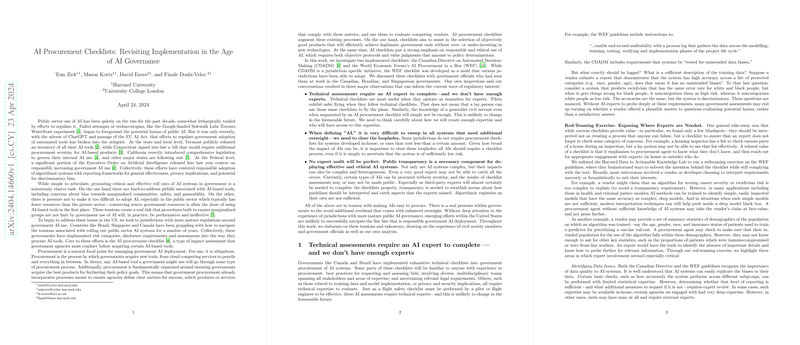AI Procurement Checklists: Striking Balance in Governance for Public Sector AI Systems
Overview and Context
The paper discusses the rising use of artificially intelligent systems within public sectors and the accompanying need for structured governance frameworks to manage AI responsibly. It emphasizes the role of AI procurement checklists in balancing technical requirements and ethical considerations amidst regulatory, resource, and expertise constraints. Using case studies from Canada, Brazil, and Singapore, this paper addresses the importance of refining these checklists to ensure they are effectively guiding the procurement processes and safeguarding against potential harms, without stifling innovation.
Effective AI Procurement Needs Technical Expertise
Key insights from the deployment of procurement tools like the Canadian Directive on Automated Decision-Making and the World Economic Forum’s AI Procurement in a Box reflect the necessity for technical expertise in AI system evaluations and deployments. The paper argues that while procurement processes are designed to align with strategic goals, the unique technical, ethical, and operational challenges posed by AI require specialist knowledge. The paper reports significant gaps in available expertise and suggests:
- Enhanced training: Boosting the AI-savviness of governmental procurement personnel.
- Expert consultations: Leveraging external AI expertise to supplement internal capabilities.
Identification of Loopholes in Procurement Processes
Several legal and procedural loopholes currently undercut the effectiveness of procurement checklists. The authors detail examples where low-cost or in-house developed AI systems avoid scrutiny under existing frameworks due to these oversights:
- Value thresholds: AI systems below a certain cost avoid rigorous procurement evaluations.
- Non-AI initial procurements: Projects not initially defined as AI but later incorporating AI elements bypass established AI-specific checks.
- Design in-house: AI systems created within a government entity do not undergo the same rigorous procurement process as externally sourced systems.
The Essential Role of Transparency
Transparency remains a linchpin in the deployment of ethical and effective AI systems in the public sector. The paper stresses the need for both substantive and procedural transparency where:
- Substantive: Full disclosure of AI system design, including data sources, model architecture, and performance metrics to the public wherever possible to allow external scrutiny and enhancement.
- Procedural: Ensuring all AI procurement processes are consistently applied and visible to prevent discretionary practices that may circumvent formal guidelines.
Speculating on Future Developments
Looking forward, the paper suggests a potential move towards more standardized global frameworks for AI procurement, akin to international standards seen in other technical fields. There is an expressed need for collaboration across governmental, private, and academic sectors to establish common standards for AI audits and transparency. Moreover, the evolving nature of AI technology and its implications necessitates continuous updates to procurement guidelines and the inclusion of AI education at all levels of governmental operations.
By addressing these areas, the authors advocate for a balanced approach to regulating AI in public sectors - one that promotes innovation and efficiency while ensuring equity, transparency, and accountability.
